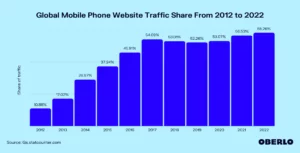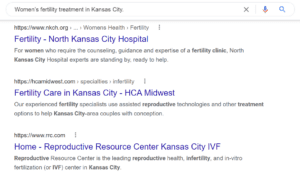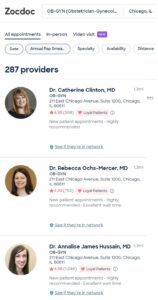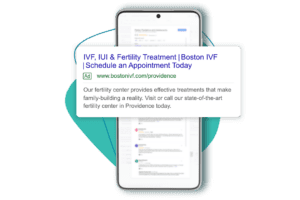Today’s consumers are accustomed to researching online before choosing a healthcare provider. Therefore, OB/GYN providers need to show up in front of a solution-seeking patient with the right information and an easy way to book an appointment.
Here’s our blueprint for a scalable digital marketing strategy that allows you to capture existing demand while building a solid reputation to fuel future growth.
Building an Optimized OB/GYN Website
Your website is the foundation of your OB/GYN digital marketing strategy because it’s your digital front door. Patients doing research will sooner or later land on your website, whether it’s the home page, a booking landing page, or an informative blog post.
OB/GYN Web Design Best Practices
Your website should always prioritize user experience, which means it must be optimized for mobile devices. That’s how people search for information, with 58.26% of all web traffic coming through mobile devices. People use their phones to quickly find providers near their homes or offices and want to be able to make a call quickly. That means your site must be:
- Fast
- Responsive
- Easy to navigate

Next, focus on elevating your user experience (UX) and improving access. For example, integrate live chatbots or messenger apps so website visitors can ask you questions. Additionally, create multiple ways to connect with you, such as a calendar booking link, CTA buttons, and contact forms.
Content That Answers Questions
Your OB/GYN website must provide answers. After all, healthcare in America is a complicated process. Meanwhile, many women still feel awkward talking to family and friends when they need help with gynecological care. Plus, not all patients initially understand what kind of service they need.
Some information patients look for include:
- Insurance information
- Treatment programs and services
- Doctors’ credentials and press recognition
- Testimonials and positive reviews
- Common female health problems and their symptoms
- FAQs
Comprehensive information on your website will build credibility, improve organic visibility for common queries, and encourage patients to book an appointment.
Local SEO
OB/GYN is a local service. Patients prefer to find a credible provider near their home or on their route to work. While some may be willing to travel further for a better provider, in most cases, local SEO is where gynecologists benefit the most.
Citations & Listings
Start with listing yourself on local business directories and niche-specific platforms. For example, many OB/GYN service providers find Zocdoc a robust platform for patient acquisition.
When choosing directories, prioritize large, trustworthy platforms with built-in scheduling and review collection functionalities because they can help you to develop a positive reputation.
Google Business Profile (GBP) Optimization
The next major piece in your local OB/GYN patient acquisition strategy is your Google Business Profile (formerly called Google My Business (GMB)) listing. Therefore, it’s important to ensure your profiles have the most recent information, including hours, address, and descriptions.
Ensure that your name, address, and phone number (NAP) is consistent between GBP and all listings.
Additionally, Google has added new attributions to GBP profiles that allow healthcare providers to market themselves to their local audience. For example, your listing shows people what insurance you accept, including Medicare. You can also indicate the languages you use to provide services and create an FAQ regarding the treatment you offer.
Geographical Keyword Strategy
You can capture consumers at their decision-making moment by targeting high-intent, solution-aware keywords. Therefore, a geographical keyword strategy is critical to your local visibility.
Some geographical keyword examples:
- Gynecologists near me
- Best gynecologist in Chicago
- Women’s fertility treatment in Kansas City.

If you target a specific audience group, incorporate their features into your keyword strategy. For example,
- Gynecologists who speak Spanish in Springfield
- Asian gynecologists near me
Well-optimized Location Pages
Treat location pages as seriously as your homepage because local consumers often land on the corresponding location page first based on their search query.
Avoid using the same copy across locations. Instead, offer location-specific information following your geographical keyword strategy. For example, provide a description of the doctors at each site, the treatment programs each location specializes in, etc.
Building a Full-Funnel Content Strategy
Gynecologists need a full-funnel SEO and content strategy that prioritizes capturing BOF conversion-ready patients while also creating helpful content for TOF and MOF queries.
For TOF patients, create educational pieces optimizing for general research keywords, such as “how often do I need to go to the gynecologist” or “how do I maintain reproductive health?” This helps demonstrate the importance of gynecology care and encourages people to seek your services.
For problem-aware MOF patients, focus on explaining your treatment program and why that’s the solution they need. For example: “What are the symptoms of a UTI?” or “How serious is a lump in your breast?” If you struggle with creating content ideas, try to see what questions are being asked on Reddit, Quora, or women’s health Facebook groups.
Finally, create content that communicates your unique selling proposition and shows that you’re the best in the field. This will help you capture BOF patients since they know the solution they need and are now looking for the best provider.
Patient Experience
Elevating patient experience should be every gynecologist’s focus. Compared to other healthcare services, OB/GYN relies more on word-of-mouth recommendations from past patients.
Since OB/GYN is an intimate matter, many women feel more comfortable asking their girlfriends for a referral. If your previous patient had a good experience, she would likely talk you up to her fellow ladies.
Similarly, if someone had an unpleasant experience at your practice, you can guarantee she’ll also warn her friends to stay away. Therefore, creating a comfortable, supportive, and respectful patient experience should be your top priority.
Aligning Marketing and Operations for OB/GYN Practices
In my years working with OB/GYN practices, I’ve learned that clever marketing alone isn’t enough. To truly thrive in women’s healthcare, you must sync your marketing efforts with your operational capabilities. This alignment is crucial for delivering on patient promises and maximizing your digital marketing impact.
Have you ever launched a successful campaign only to find your practice overwhelmed? It’s a common pitfall. That’s why I advise clients to ensure their marketing complements their ability to provide quality care.
Remember, every ad is a promise your practice must fulfill. Are you ready to align your marketing and operations for sustainable growth? Start with these key areas:
Practice Capacity Alignment
Remember how we discussed the importance of local SEO and Google Business Profile optimization? Now, let’s take it a step further. Before ramping up your marketing efforts for a specific location, it’s essential to understand its current capacity.
For example, if your Miami clinic is fully booked for the next two months, aggressively marketing that location wouldn’t make sense. Instead, redirect your ad spend to your Tampa office, which has more immediate availability. This approach ensures you’re not just attracting patients but attracting them to the right place at the right time.
Best practice: Set up bi-weekly meetings between your marketing team and practice managers to discuss current capacity levels and adjust marketing efforts accordingly.
Service Line Alignment
We’ve talked about creating content that answers patient questions, but let’s dig deeper into aligning your content strategy with your most valuable service lines. Consider which OB/GYN services have the highest patient lifetime value or lead to the most referrals.
For instance, if your fertility treatments have a high success rate and often lead to long-term patient relationships, you might prioritize content marketing and PPC campaigns for these services. This means paying attention to other areas rather than allocating resources where they’ll have the most significant impact.
Best practice: Conduct a quarterly review of your service lines with your medical team and finance department. Use this information to guide your content creation and ad spend priorities.
Messaging Alignment
While we’ve emphasized the importance of patient-centric content, it’s equally crucial that your marketing messages align with your practice’s values and operational realities. Your OB/GYN practice likely prides itself on providing personalized, compassionate care. As such, ensure your marketing reflects this.
To illustrate, if you’re marketing a new minimally invasive surgical technique, make sure your operational team is fully prepared to deliver on this promise. There’s nothing worse than attracting patients with a message that your practice can’t fulfill.
Best practice: Before launching any major marketing campaign, hold a review session with your medical staff to ensure the messaging accurately represents your capabilities and aligns with your practice’s ethos.
Technology Alignment
Earlier, we discussed the power of PPC advertising and social media campaigns, but the effectiveness of these tools often relies on data from your practice management systems. To truly leverage the power of data-driven marketing, you need buy-in from your operational team.
For instance, implementing a new CRM system might greatly enhance your ability to target marketing efforts, but it could initially disrupt your front desk staff’s workflow. By involving them in the decision-making process and highlighting the benefits (like reduced no-shows or improved patient communication), you’re more likely to gain their support.
Best practice: When considering new marketing technologies, form a small committee with representatives from marketing, IT, and front-line staff to evaluate options and plan implementation.
How to Achieve Alignment?
Now, let’s talk about how to make this alignment happen. It’s not always easy, but the payoff in marketing effectiveness and practice growth is tremendous.
- Identify Shared Goals: Start by getting your marketing and operations teams in the same room. Discuss overarching goals like improving patient satisfaction, increasing referrals, or expanding specific services. When everyone understands the big picture, it’s easier to work together.
- Foster Open Communication: Create regular touchpoints between marketing and operations. This could be a monthly lunch meeting where the marketing team shares upcoming campaigns and the operations team provides feedback on current challenges.
- Walk in Their Shoes: Encourage your marketing team to spend a day shadowing front desk staff or observing patient flow. This firsthand experience can provide invaluable insights for creating more effective, operationally aligned marketing strategies.
- Celebrate Successes Together: When a marketing campaign leads to a surge in new patients, don’t just pat the marketing team on the back. Recognize the operational staff who made it possible by providing excellent care and managing the increased workload.
- Provide Ongoing Education: Help your operational staff understand the basics of digital marketing. Similarly, ensure your marketing team understands day-to-day practice operations well. This mutual understanding fosters better collaboration.
Remember, achieving alignment is an ongoing process, not a one-time effort. You’ll create a more cohesive, effective OB/GYN practice by consistently working towards this goal.
Online Reputation Management
OB/GYN healthcare providers rely heavily on positive reputations to fill their patient pipeline. Additionally, reviews are also closely tied to your local SEO and online patient acquisition.
Also, 66.1% of healthcare consumers consider reviews older than 18 months out of date. Therefore, you must invest in review solicitation and long-term reputation management to build a reputation that demonstrates the quality of care you provide.
Gathering Positive Reviews
If you leave review generation up to chance, you’ll likely receive more negative than positive reviews. Dissatisfied patients are much more inclined to leave negative reviews. To generate a high volume of positive reviews, you must develop a repeatable review solicitation process.
The easiest way to start is to ask loyal patients. From there, train your team on review solicitation best practices. Then, you can provide scripts and help them identify the best point in the patient experience to ask.
To truly scale review solicitation, you must invest in a technology like Podim or BirdEye. They integrate with your EHR or CRM and send automated review requests via text or email after an appointment. The messages make the review process easy, and you can send them directly to the review platform you want them to go.

Get more tips for generating positive reviews
Reputation Management Best Practices
Building a positive reputation is only half of the work. The other half lies in online reputation management. To develop a comprehensive reputation management system, start by following these best practices.
- Regularly check your listings for unwanted reviews and spam comments
- Respond to negative reviews publicly and privately try to resolve the issue
- Invest in review solicitation software to automate the workflow
- Collect high-quality testimonials and share success studies across digital channels
- Write an engaging About Us page
- Invest in media relations to establish your reputation and credibility
PPC Strategy for OB/GYN
Google PPC ads are highly effective for OB/GYN service providers wanting to reach purchase-ready BOF clients in their target areas. With Google PPC ads, gynecologists can target high-intent keywords like “OBGYN near me.”
Building An Effective Account Structure
You need an effective Google Ads account structure to reduce Cost Per Acquisition (CPA) and maximize conversion. Otherwise, you’d only be wasting your ad budget. For example, Boston IVF, a national fertility treatment institution, gained a 25% conversion increase with a 27% decrease in CPA after optimizing its Google Ads account structure.

Currently, Google Ads accounts fall onto a spectrum. On one end is the segmented account, which provides more control and works best for larger organizations that designate different spending budgets for each location. On the other end is the consolidated account, which minimizes the number of campaigns and ad groups to maximize impression. Consolidated accounts also work wonders with Google’s AI-powered bidding tool.
OB/GYN providers benefit the most from a hybrid account structure that balances control and automation. That way, the organization can still control each location’s spending while allowing Google’s smart bidding strategy to optimize your spending.
Google Ads Best Practices
With Google PPC ads, you already have a head start by capturing BOF patients seeking an urgent solution. All that’s left is to follow PPC best practices for healthcare providers so your ads provide a positive user experience and move consumers forward in their patient journey.
Some strategies to implement include
- Create unique landing pages for each campaign
- Optimize landing pages for mobile experience
- Use click-to-call ads for mobile users
- Test different headlines, body text, and extensions to find the ones with the highest conversion quality
- Improve your attribution profile
Learn more about PPC strategies for OB/GYN
Social Media Advertising
Once you’ve fully captured BOF leads with Google PPC ads, you can consider leveraging paid social media advertising to tackle the entire funnel. Again, start with conversion ads targeting purchase-ready consumers and incorporate instant experience and call ads to make conversion easy.
After maximizing BOF lead capture, you can move up the funnel to tackle MOF and even TOF consumers. In other words: create content to generate demand. For example, discuss why routine gynecologist visits are important, warning signs to watch for, and women’s healthcare routines.
While educational content focuses less on instant conversion, this full-funnel approach will build a sustainable patient acquisition strategy that continues to move leads forward in your pipeline while building trust with them. That way, when a patient is ready to buy, they naturally come to you.
Learn more about engaging patients with a full-funnel strategy
Data-Driven Digital Marketing Strategy for Gynecologists
Every OB/GYN digital marketing strategy must consider how they can glean insight from their data. Data-driven digital marketing is the only way to ensure that you progress in the right direction, as it clarifies how each aspect is performing and allows you to take informed actions.
Implementing Closed-Loop Reporting (CLR) in Healthcare
CLR provides OB/GYN providers with what happens after a campaign generates a lead. Does that lead to a patient? How many additional interactions did it take to reach conversion if it does? If not, where did the lead drop? This information allows providers to make data-driven decisions on digital marketing strategy optimization.

When implementing CLR, start with finding the attribution model that resonates the most with your organizational goals:
- First-touch attribution documents the initial interaction that started the patient’s journey.
- Last-touch model captures the last activity before a consumer converts to a lead.
- Linear model assigns equal credits to each step on the patient’s conversion journey and maps out their entire route.
- Multi-touch model assigns credits proportionally based on how much impact each interaction had on patient acquisition, allowing you to visualize key moments.
Learn more about closed-loop reporting in healthcare marketing
Data-Driven Marketing Best Practices
Create a single source of truth by integrating your CRM, EHR, and other marketing systems into one centralized system. Develop interactive, comprehensive, and shareable dashboards so your teams can communicate and collaborate across departments.
Conclusion
Today’s gynecologists need a digital marketing strategy to reach new patients. In the end, your goal is to be present in front of consumers looking for a solution while educating them about why OB/GYN care must be a part of their healthcare routine.
When developing your digital marketing strategy, always keep your patients in mind. Provide an effortless process, an intimate, secure environment, and a respectful, positive experience, and you will fill up your patient pipeline in no time.

